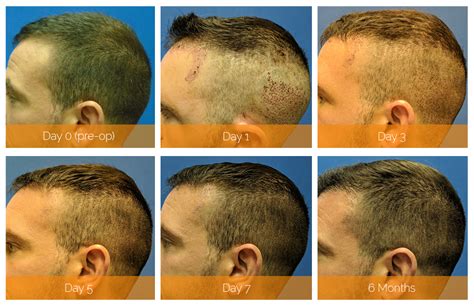Learn about the preparation, procedure, and post-care for hair transplantation. Get tips for a fast recovery in this comprehensive guide.
Understanding Hair Transplantation
Contents
Hair transplantation is a surgical procedure that involves removing hair follicles from one part of the body (the donor site) and implanting them onto the bald or balding part of the body (the recipient site).
The procedure is primarily used to treat male pattern baldness, but it can also be used to restore eyelashes, eyebrows, beard hair, and to fill in scars caused by accidents or surgery.
The most common type of hair transplantation is follicular unit transplantation (FUT), which involves removing a strip of scalp tissue from the donor site and then dividing it into grafts before implanting them onto the recipient site.
Another popular type of hair transplantation is follicular unit extraction (FUE), which involves individually removing hair follicles from the donor site and then implanting them onto the recipient site.
Both FUT and FUE are performed under local anesthesia and on an outpatient basis, meaning no overnight stay is required.
Preparation for Hair Transplantation
Before undergoing hair transplantation, it is essential to thoroughly prepare for the procedure. Proper preparation will help ensure a successful outcome and minimize the risk of complications. Here are some important steps to take in preparation for hair transplantation:
Research: The first step in preparing for hair transplantation is to thoroughly research the procedure and the different options available. This includes understanding the different techniques, such as FUE and FUT, as well as the potential risks and benefits of each.
Consultation: It is crucial to schedule a consultation with a qualified hair transplant surgeon. During the consultation, the surgeon will evaluate your hair loss, discuss your goals, and determine if you are a good candidate for the procedure.
Medical Evaluation: In preparation for hair transplantation, it is important to undergo a thorough medical evaluation. This may include blood tests and other diagnostic tests to ensure that you are in good overall health and a suitable candidate for the procedure.
Quit Smoking: For those who smoke, it is important to quit smoking in the weeks leading up to hair transplantation. Smoking can interfere with the body’s healing process and increase the risk of complications.
Arrange Transportation: On the day of the procedure, it is important to have transportation arranged to and from the clinic. This will help ensure a stress-free experience and allow you to focus on your recovery.
The Procedure of Hair Transplantation
When it comes to hair transplantation, the procedure is a critical aspect that potential patients should be familiar with. The process typically starts with a consultation with the surgeon, where the patient’s hair loss and desired outcomes are discussed. Once the decision to proceed with the surgery is made, the first step of the actual procedure is administering local anesthesia to the donor and recipient areas. This ensures that the patient remains comfortable throughout the surgery.
Next, the surgeon will harvest healthy hair follicles from the donor area, typically the back of the head. This process can be done using the traditional strip harvesting method or the more advanced follicular unit extraction (FUE) technique. The harvested hair follicles are then prepared for transplantation. The recipient area is carefully prepped, and tiny incisions are made to accommodate the transplanted hair follicles.
Once the incisions are made, the surgeon meticulously places the hair follicles into the recipient area at the correct angle and density to achieve natural-looking results. The entire procedure can take several hours, depending on the extent of the hair loss and the number of grafts being transplanted.
After the transplantation is complete, the surgeon will provide detailed instructions for post-transplantation care, including how to clean and protect the newly transplanted hair. It’s important for patients to follow these instructions closely to ensure the best possible outcomes and promote proper healing.
Overall, the procedure of hair transplantation is a precise and intricate process that requires skill and expertise on the part of the surgeon. Patients can expect to experience some level of discomfort and swelling in the days following the surgery, but with proper care and patience, they can look forward to natural, long-lasting results.
Post-Transplantation Care
After undergoing a hair transplantation, it is crucial to take proper care of the newly transplanted hair in order to ensure successful results. Post-transplantation care involves following certain guidelines and making necessary lifestyle adjustments to promote healthy growth of the transplanted hair.
First and foremost, it is important to protect the transplanted area from direct sunlight for at least a few weeks. This can be achieved by wearing a hat or applying sunscreen to the scalp. Exposure to UV rays can lead to damage and inhibit the healing process of the transplanted hair follicles.
Furthermore, it is advisable to avoid strenuous physical activities and heavy lifting for a certain period of time following the procedure. This is to prevent any strain or pressure on the scalp, which could potentially affect the grafts.
In addition, following the post-operative instructions provided by the surgeon is essential for optimal results. This may include specific guidelines on how to wash the hair, when to resume normal daily activities, and any medications or products to be used on the scalp.
Proper nutrition and hydration are also important aspects of post-transplantation care. A well-balanced diet and adequate hydration can aid in the healing process and support the growth of new hair.
Tips for Fast Recovery after Hair Transplantation
After undergoing a hair transplantation procedure, it’s important to take the necessary steps to ensure a smooth and speedy recovery. Here are some tips to help you achieve a fast recovery:
1. Follow the post-operative instructions: Your surgeon will provide you with specific guidelines to follow after the procedure. It’s crucial to adhere to these instructions, which may include avoiding strenuous activities, refraining from touching the transplanted area, and taking prescribed medications.
2. Protect the transplanted area: It’s essential to protect the transplanted area from any potential harm. This includes avoiding direct sunlight, wearing a hat when outdoors, and refraining from scratching or rubbing the scalp.
3. Maintain a healthy diet and lifestyle: Consuming a balanced, nutritious diet can aid in the healing process. Additionally, avoiding smoking and excessive alcohol consumption can contribute to a faster recovery.
4. Attend follow-up appointments: Regular follow-up appointments with your surgeon are crucial for monitoring the progress of your recovery. During these appointments, any concerns or issues can be addressed, and the surgeon can provide further guidance on caring for the transplanted area.
5. Be patient and diligent: While you may be eager to see the results of your hair transplantation, it’s important to be patient and diligent in following the recovery guidelines. By being mindful of your actions and adhering to the recommended care routine, you can help ensure a successful and speedy recovery.











